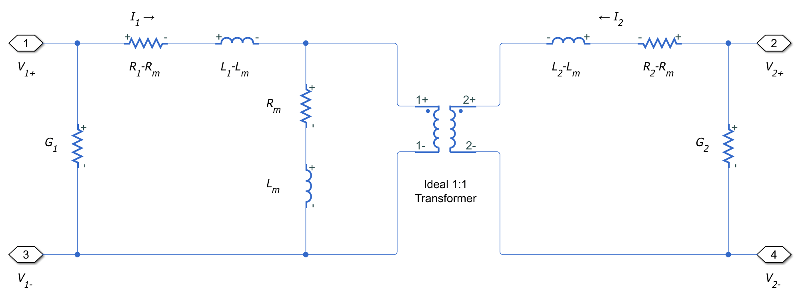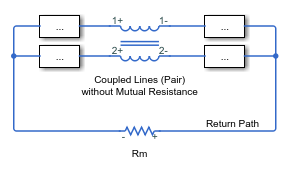Coupled Lines (Pair)
Magnetically couple two lines
Libraries:
Simscape /
Electrical /
Passive /
Lines
Description
The Coupled Lines (Pair) block models two magnetically coupled lines. Each line has a self-inductance, series resistance, and parallel conductance. In addition, there is a mutual inductance and mutual resistance between the two lines.
Use this block when the magnetic coupling between the two lines is nonnegligible. These effects are most prominent when:
The lines are parallel and close together.
The self-inductances of the lines are high.
The AC frequency of the network is high.
To model magnetic coupling of a three-phase line, use the Coupled Lines block.
Equivalent Circuit
The figure shows the equivalent circuit for a pair of coupled lines.

Here:
R1 and R2 are the series resistances of lines 1 and 2, respectively.
L1 and L2 are the self-inductances of lines 1 and 2, respectively.
Rm is the mutual resistance between the two lines. You can use this parameter to account for losses in a common return path.
Lm is the mutual inductance between the two lines.
G1 and G2 are the leakage conductances of lines 1 and 2, respectively.
V1 and V2 are voltage drops across lines 1 and 2, respectively.
I1 and I2 are the currents through the resistors R1-Rm and R2-Rm, respectively.
Equations
The defining equation for this block is:
where:
I1 and I2 are, in general, not equal to the currents in line 1 and line 2. These terminal currents make up the vector:
Inductive Coupling
To quantify the strength of the coupling between the two lines, you can use a coupling factor or coefficient of coupling k. The coupling factor relates the mutual inductance to the line self-inductances:
This coupling factor must fall in the range , where a negative coupling factor indicates a reversal in orientation of one of the coils. The magnitude of k indicates:
— There is no magnetic coupling between the two lines.
— The two lines are loosely coupled and mutual magnetic effects are small.
— The two lines are strongly coupled and mutual magnetic effects are large.
Mutual Resistance
If the two lines share a common return path, you can model the resistance of this return path using the Mutual resistance parameter. This workflow is equivalent to setting the Mutual resistance to zero and explicitly modeling the return path resistance Rm, as shown in this diagram.

If the two lines do not share a common return path, set the mutual resistance parameter to zero and model each of the return resistances explicitly.
Ports
Conserving
Parameters
Extended Capabilities
Version History
Introduced in R2018a
